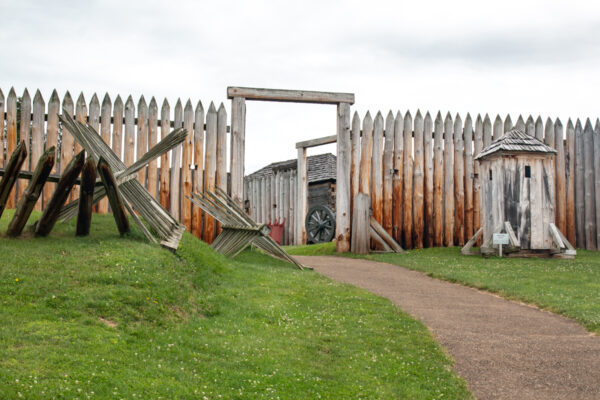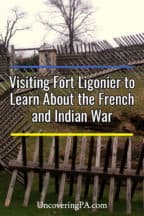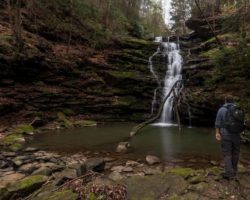There is a significant amount of French and Indian War history in southwestern PA, and one of the best spots to visit to visit to learn about this history is Fort Ligoner.
Fort Ligonier is a recreated 17th-century fort located in the town of Ligoner in Westmoreland County, PA. The fort served as an important stop on the path to present-day Pittsburgh to help in the capture of Fort Duquesne at what is now Point State Park.
After his defeat four years earlier at Fort Necessity, a young George Washington was part of the British Army’s Forbes Campaign that cut a new path out to western Pennsylvania and built a fort in Loyalhanna in 1758. While building what would become Fort Ligonier, the fort was attacked twice but didn’t fall to the enemy.

Ultimately, as the British pressed beyond Fort Ligonier to Fort Duquesne in Pittsburgh, the fort became an important outpost for troops and supplies, as well as communications. The size of the fort swelled to over 5,000 troops, Native Americans, merchants, women, and children by November 1758, making it the second largest town in Pennsylvania behind Philadelphia.
Returning to the front lines, George Washington spent a bit of time at the fort. Ultimately, with the defeat of the French and Native Americans in 1763, the fort became unnecessary and was decommissioned in 1766, after Pontiac’s Rebellion.
The site of the fort set abandoned for many years with what remained becoming hidden in the landscape. In the 1930s, the Daughters of the American Revolution began the process of preserving the site and, by 1953, the fort was reconstructed and opened to the public.

Today, Fort Ligonier has been rebuilt to appear much as it would have in the 1750s and a nice museum is also located on the grounds.
Visits start in the museum, which offers a fantastic look at not only the events that happened here, but on the French and Indian War as a whole. They also offer the best look in Pennsylvania at the entirety of the world-wide Seven Years’ War that was sparked by the events in the Laurel Highlands.

The displays here are really well done, having been totally rehabilitated in the last decade, and include a variety of signage, photos, and artifacts to really bring things to life. I especially enjoyed the timeline of the war and the painting gallery during my visit.
The highlight of the museum, however, has to be the items on display that once belong to George Washington.

You’ll likely first notice a collection of papers that are from Washington’s personal notes. Despite his wishes that they be destroyed, the pages were saved and are now in the museum’s collection. Unfortunately, replicas are often on display, but the originals are put out several times a year to be seen by the public.
Even more interesting, though, are the two saddle pistols that you’ll see just before exiting the museum. Given to George Washington by the Marquis de Lafayette during the Revolutionary War, the pistols were carried by Washington at Valley Forge, Yorktown, and when he rode out to put down the Whiskey Rebellion.

Eventually, the guns were presented to President Andrew Jackson by Washington’s family and making their way back to Lafayette’s family before finally ending up here. The original guns are on display in the center of the room dedicated to Washington and are, in my opinion, worth the price of admission by themselves.
Another less historically-significant, but still fun hidden gem to look for is a small photo of a young Fred Rogers of TV fame. Rogers grew up in nearby Latrobe and his mother was part of the Daughters of the Revolution group that started the process of preserving the fort.
There is a photo of Rogers on one of the signs at the dedication of the fort before it was reconstructed.

Once you’ve finished viewing the museum, venture outside to visit the reconstructed Fort Ligonier. The fort occupies the same ground as the original did over 250 years ago and gives you a great chance to see what a frontier fort would have looked like during the French and Indian War.
The reconstructed fort is very well done and was rebuilt based on archeological digging and research to make it as authentic as possible, including the really cool wooden walls that sound several structures.
Several buildings have been built including the officer’s mess, hospital, barracks, and General Forbes’ headquarters. Inside each building are furniture and mannequins that allow you to imagine what life was like along the Pennsylvania frontier.

If you’re lucky, you might even see costumed interpreters who are available to help visitors better understand what they are seeing and the fort’s significance.
Overall, I really enjoyed my visit to Fort Ligonier because I was able to learn about a period of world history that I know little about. If you are a history buff or just want to learn more about the history of the United States, I would definitely recommend a visit to Fort Ligonier.
Note: I was given complimentary admission to Fort Ligonier in order to facilitate this review. However, the opinions expressed in the article are my own and were not subject to review.
Looking for other great places to visit in the area? Check out Historic Hanna’s Town, the Compass Inn Museum, Idlewild and SoakZone, and Braddock’s Battlefield History Center.





 "
"




Another great recommendation Jim which I fully endorse. This is certainly a place I lost numerous hours to being absorbed by the displays and reconstructed fort. A wonderful way to spend an afternoon.
I must admit that as a Brit we never really studied the Seven Year War either which is I think, a great shame. This was literally the first ever World War and the outcome significantly shaped the world map for many generations and defined much of the old British Empire.
Until now all I ever knew is that us Brits and French were often at war with each other. Seeing places like this reinforces the scale and nature of the conflict and world back then.
Interesting perspective, check out the Fort Pitt Museum at Point State Park in Pittsburgh. It is dedicated to the war.